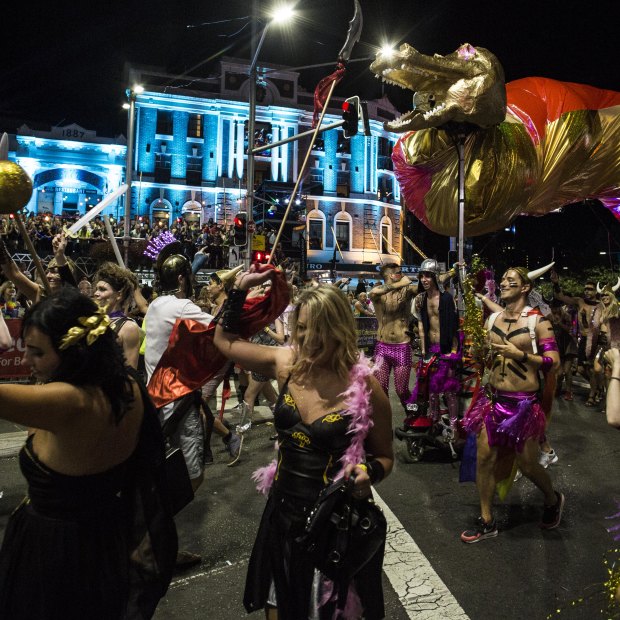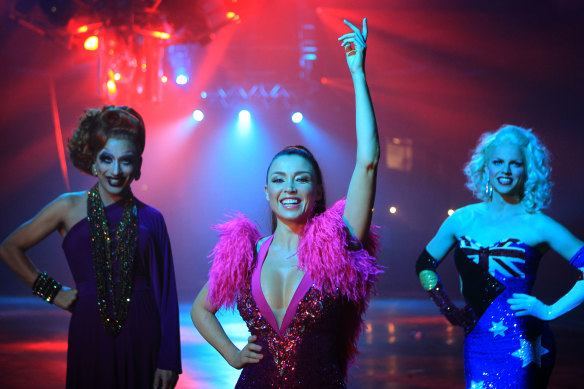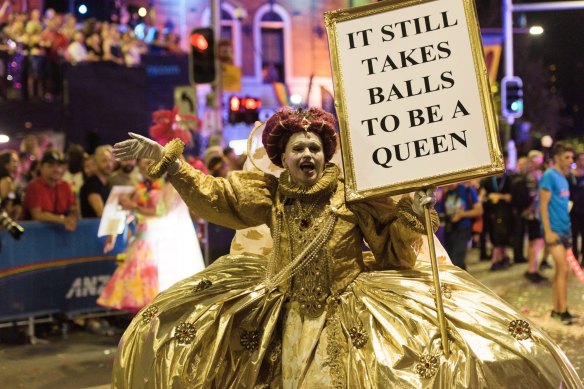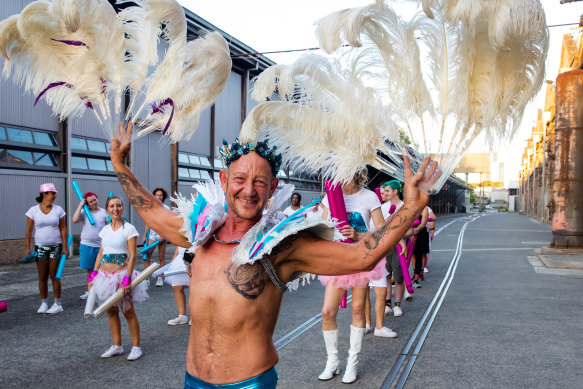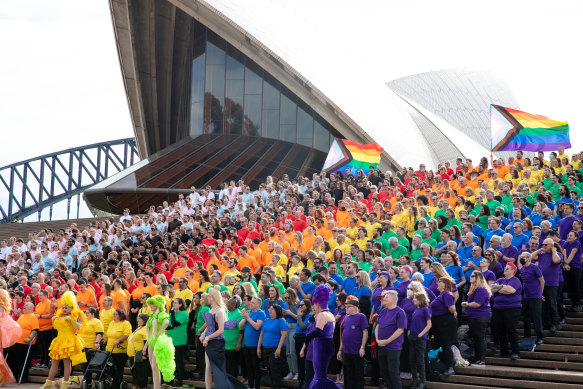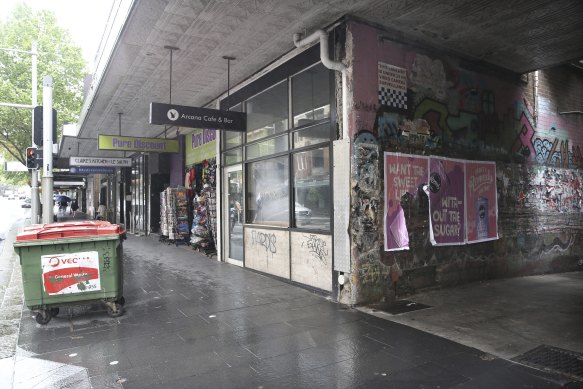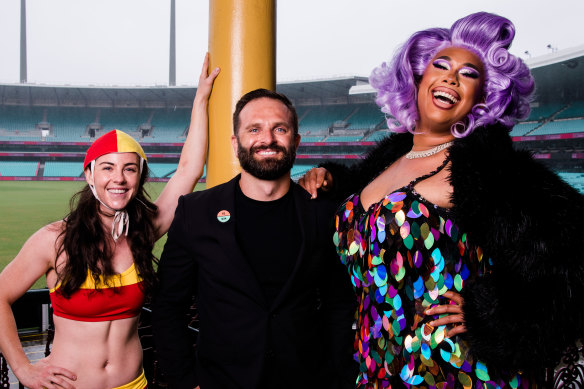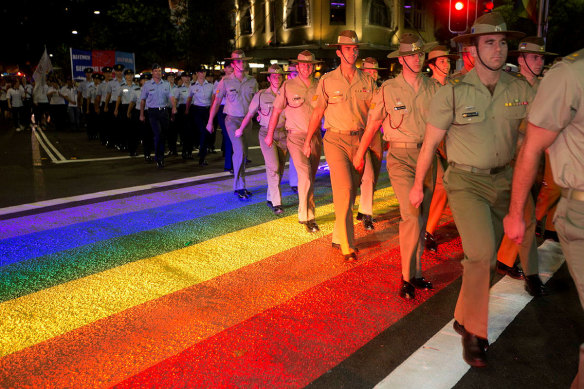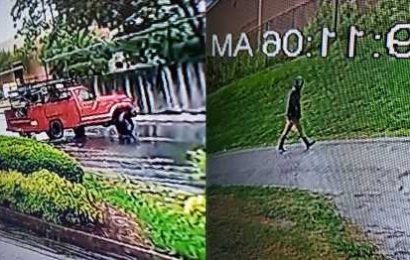By Andrew Taylor and Billie Eder
Sydney Gay and Lesbian Mardi Gras was once known as a sexually liberating parade. Credit:Dominic Lorrimer
It is hard to imagine Courtney Act clutching her pearls in horror over the sights and sounds of the Sydney Gay and Lesbian Mardi Gras.
But Australia’s most famous drag queen confesses she was taken aback by the dancing penises, fetish-wear and nudity at her first Mardi Gras parade more than 20 years ago.
“I remember thinking: why can’t they just be normal?” Act says. “I later realised that’s the point. We’re not like everyone else. The point is the parade liberates people’s thinking about their bodies and sexuality.”
Courtney Act, right, with Dannii Minogue, centre, and Bianca Del Rio ahead of the 2015 Mardi Gras. Credit:James Alcock
’I remember thinking: ‘why can’t they just be normal?’
Famous for the street parade and raucous after-party, Mardi Gras is a two-and-a-half week festival of arts and community events that kicks off on February 17.
This year, the annual celebration is somewhat confusingly encompassed by Sydney WorldPride and includes a human rights conference and march across the Harbour Bridge.
Sydney’s gay Christmas, as Mardi Gras is sometimes nicknamed, means the usual deluge of corporate logos in rainbow colours and squabbles over the purpose of the event.
Left-wing group Pride in Protest wants to banish big business and the police from the parade and return Mardi Gras to what it regards as its protest roots to challenge systems of injustice.
In contrast, Destination NSW, the state’s tourism agency, calls Mardi Gras a “colourful collision of creativity and culture” and a festival of love, equality and diversity.
The street parade was once littered with dancing penises, fetish-wear and nudity.Credit:James Brickwood
Mardi Gras chief executive Albert Kruger says the parade has always featured a mix of celebratory and political messaging.
“It is down to each individual community group who marches in the parade to decide what message they want to put out,” he says. “Some want to celebrate and some want to protest.”
Party or protest, fights over whether Mardi Gras is too political or too frivolous have been around since the event’s early days. In 1980, the Mardi Gras Task Group was asking about the goal of the event.
“Is it a political demonstration to demand gay rights, or is it a celebration of coming out, with its only political goals being to demonstrate the size and variety of the gay community and to establish its right to be?”
At the height of the AIDS crisis, Reverend Fred Nile called for Mardi Gras to be cancelled and replaced with lectures on the dangers of AIDS and homosexual practices, The Sydney Morning Herald reported in 1987.
“The so-called Gay Mardi Gras will do more in one night to spread AIDS in Australia, especially in Sydney, than any other single event,” he said.
A regular target of derision at Mardi Gras, Nile last year told the Herald’s Peter FitzSimons he was sorry for praying for rain on the parade.
Ken Davis, who took part in the first Mardi Gras in 1978, says the parade still provides a forum to express political views, but was increasingly constrained by organisers, governments, police and sponsors.
“The parade can still be glamorous, but its creativity and wit are attenuated, its sexual and political impact diluted,” he says.
Davis believes broadcasters, government and big business want a more family-friendly parade, which he says dampens creativity, humour, sexuality and politics.
“For the government and sponsors, the key question is how to maximise profits, primarily for travel and hospitality businesses, during WorldPride or Mardi Gras season,” he says.
Davis says he believed the parade was still a symbol of queer freedom and showed Sydney as an open, accepting, free and cosmopolitan city.
“The parade should make us rejoice in our diversity, and unexpectedly and wittily challenge the way we see big issues, not reinforce public loyalty to governments or companies,” he says.
A decision to reject the NSW teachers’ union and the state’s largest transgender service centre from the parade, which have both marched previously, attracted criticism. And for some people, the parade has always fallen short when it comes to the commitment and representation of the entire LGBTIQ community.
Trans Pride Australia president AJ Brown says the name Sydney Gay and Lesbian Mardi Gras excludes the trans and gender diverse community.
“It’s [the event] struggled with understanding what the community needs are, and I feel that’s because they’ve never really had anyone with lived experience be a part of that decision-making,” Brown says.
Corporate involvement in Mardi Gras has been another source of controversy – a $33,000 condom sponsorship deal that would have branded the event with Playboy magazine’s bunny trademark was rejected in 1993.
A year later, Cadbury Schweppes withdrew advertising from the TV show Hey, Hey It’s Saturday because the show planned a live cross to the parade.
Trans Pride President AJ Brown practicing ahead of the parade in 2022.Credit:Edwina Pickles
A partnership with Sexpo was rejected in 2020 to protect the event’s identity as a “family-oriented festival”.
Mardi Gras earned $9.83 million in revenue last year, including $3.97 million in sponsorship – compared to $3.79 million in 2021, $3.63 million in 2020 and $3.26 million in 2019.
Pride in Protest last year said the parade was becoming “an extension of the corporations it has a relationship with” and “pink-washing” the reputations of its corporate sponsors.
But a 2021 survey of Mardi Gras members found only 18 per cent had concerns about corporate sponsors, which this year includes Qantas, Coles Group, American Express, Procter and Gamble, Optus and Meta.
Mardi Gras has an ethical charter that helps the organisation select sponsors, and big business must have robust diversity and inclusion programs, Kruger says. “We choose partners who reflect the values held closely by the LGBTQIA+ community.”
Mardi Gras would also be a much smaller affair – and provide less work to members of the queer community – without corporate and government sponsors, Kruger says.
The 45th Sydney Mardi Gras parade will take place as Sydney hosts WorldPride, the world’s largest LGBTQ festival.Credit:Edwina Pickles
A spokesperson for Coles, which is supporting the event for the first time in 2023, said about 10 per cent of its employees identify as being LGBTIQ, and it is eager to demonstrate the company’s support for diversity and inclusion.
“We have team members flying in from across the country to take part in the festivities, and they are very excited and proud to be part of it,” the spokesperson says. “We continue to work hard in growing our Pride network and connections to local, rural and regional communities.”
The supermarket giant, which introduced gender affirmation leave in 2022, said it already had existing commitments to sponsoring events such as Wagga Wagga Mardi Gras, Newcastle Pride Festival and the Pride Cup.
However, sponsorship isn’t the only concern for parade-goers.
COVID-19 forced Mardi Gras to abandon its traditional parade route along Oxford Street in Darlinghurst for two years, but joy at this year’s return of the street parade is tinged with worry about the shabby state of Oxford Street where an estimated one-third of the shops are empty.
Yet even these concerns are hardly new. The state government unsuccessfully tried to persuade organisers to move the parade and after-party from Oxford Street to Homebush Bay more than a decade ago.
Mardi Gras’ then chairman, David Imrie in 2009 said Oxford Street had changed “massively” since the early 1990s.
Abandoned and unleased shopfronts line Oxford Street in Darlinghurst.Credit:James Alcock
“There’s street violence, there’s a number of empty stores …,” he said. “It’s probably not the gay ghetto it once was … There are other events [such as in Brazil] where it’s done in a stadium, which then becomes the party.”
State and federal Liberal MPs will once again march in this year’s Mardi Gras as part of Liberal Friends of LGBTQI+ parade entry.
Despite tensions between the LGBTIQ community and conservative side of politics, co-chair Jack Barlow says the group felt welcome at the parade.
“Having parties from across the political spectrum represented at Mardi Gras is simply a reflection of the community,” he says.
Barlow also welcomes the presence of major companies and government agencies in the parade.
Albert Kruger, centre, at the Sydney Cricket Ground for the Mardi Gras parade in 2021.Credit:James Brickwood
“For me personally I love seeing the NSW government swap over to the rainbow waratah for Mardi Gras,” he says. “It’s a point of pride to see the government throw its support behind our community.”
Mardi Gras prides itself on diversity and inclusion, but its reputation as the city’s best party prompted concerns in the 1990s that it was attracting too many heterosexual revellers and losing its identity as an LGBTQI event.
For an event that began in 1978 as a protest against police violence and led to thousands of arrests, the presence of the police continues to be controversial, with Pride in Protest campaigning to expel police officers who have participated in Mardi Gras since 1996.
Sydney Lord Mayor Clover Moore last year warned police she did not want visitors confronted by armed officers and drug dogs at next year’s WorldPride festival, amid concerns about “heavy-handed policing”.
But NSW Police assistant commissioner Anthony Cooke says the police force will conduct a high-visibility operation that includes the dog unit.
The parade has also faced pressure to stop police officers from conducting “decency checks” on participants and cancel an agreement over policing of the event.
But Kruger defends the policing of the event and says an accord between Mardi Gras and the NSW Police is focused on harm reduction and ensuring the safety of people attending events.
There are many LGBTQIA+ members serving in the Australian Defence Force.Credit:Department of Defence
Cooke says police participation in Mardi Gras is a demonstration of support for its LGBTIQ employees.
“We acknowledge our history, and therefore the importance of working closely with the community and in participating in the Mardi Gras Festival, to reduce barriers to reporting crime, and to publicly and proudly state our support for the LGBTIQ community,” he says.
Defence LGBTI Information Service vice president Nathan Howarth says there are many LGBTIQ members serving in the Australian Defence Force as well as the police and emergency services.
“If we are to move forward as a community, we need to acknowledge, and learn from, mistakes made in the past,” he says.
Those words ring true for The Sydney Morning Herald, which in 2016 apologised for outing scores of people involved in a 1978 gay rights protests, publishing their names, addresses and occupations in the newspaper.
The NSW Parliament in 2016 also apologised to protestors over the discrimination they suffered at the march that became Sydney’s first Mardi Gras.
Howarth also says more straight people do not make events less queer and no one should feel pressure to come out to attend Mardi Gras.
“Excluding straight people would come at the cost of eliminating key persons in our community, including straight trans people and straight and/or cis asexual, as well as those who may be closeted or questioning their sexuality,” he says.
Most Viewed in National
Source: Read Full Article
